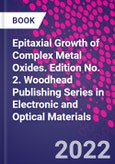Epitaxial Growth of Complex Metal Oxides, Second Edition reviews techniques and recent developments in the fabrication quality of complex metal oxides, which are facilitating advances in electronic, magnetic and optical applications. Sections review the key techniques involved in the epitaxial growth of complex metal oxides and explore the effects of strain and stoichiometry on crystal structure and related properties in thin film oxides. Finally, the book concludes by discussing selected examples of important applications of complex metal oxide thin films, including optoelectronics, batteries, spintronics and neuromorphic applications.
This new edition has been fully updated, with brand new chapters on topics such as atomic layer deposition, interfaces, STEM-EELs, and the epitaxial growth of multiferroics, ferroelectrics and nanocomposites.
Please Note: This is an On Demand product, delivery may take up to 11 working days after payment has been received.
Table of Contents
Part 1 Epitaxial growth techniques
1. Molecular beam epitaxy for the growth of complex oxide materials
2. Physical vapour deposition for the growth of complex oxide materials
3. Chemical vapour deposition for the growth of complex oxide materials
4. Pulsed laser deposition for the growth of complex metal oxides
5. Sputtering of complex metal oxides
6. Synthesis and surface engineering of complex metal oxides by atomic layer deposition
7. Hybrid molecular beam epitaxy for the growth of complex metal oxide materials
8. High pressure synthesis of transition metal oxides
Part 2 Epitaxial growth and functional properties of complex metal oxides
9. Epitaxial growth of ferroelectrics and multiferroics
10. Growth study of epitaxial oxide thin films using Reflection high-energy electron diffraction (RHEED)
11. Epitaxial growth of piezoelectrics
12. Epitaxial growth of superconducting oxides
13. Epitaxial growth of magnetic oxide thin films
14. Strain engineering during epitaxial growth of complex metal oxides
15. Defects, impurities and transport phenomenon in complex oxide crystals
16. In situ x-ray scattering of epitaxial oxide thin films
17. Scanning probe microscopy (SPM) of epitaxial oxide thin films
Part 3 Applications of complex metal oxides
18. Optoelectronics: an application of complex metal oxides
19. Spintronics: an application of complex metal oxides
20. Thermoelectric complex metal oxides
21. Solid oxide fuel cells based complex metal oxides
22. Applications of complex metal oxides in catalysis
23. PiezoMEMS based on complex metal oxides








